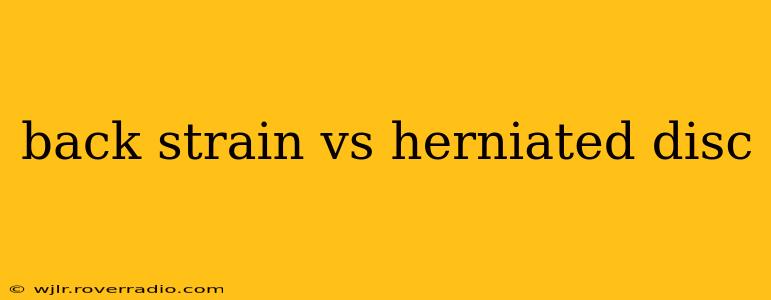Back pain is a common ailment, affecting millions worldwide. Two frequent causes are back strain and herniated disc, both presenting with similar symptoms, but requiring different treatment approaches. Understanding the key differences is crucial for proper diagnosis and effective management. This article will delve into the distinctions between these two conditions, answering common questions people have about back pain.
What is a Back Strain?
A back strain, also known as a muscle strain or sprain, involves an injury to the muscles and ligaments in your back. This often occurs due to sudden movements, overuse, or poor posture. The damage can range from minor stretching to a complete tear of the muscle or ligament fibers. Think of it like pulling or overstretching a muscle, similar to what might happen in your hamstring after a sprint.
Symptoms of a back strain typically include:
- Localized pain: Pain is usually focused in the affected area of the back, often worsening with movement.
- Muscle spasms: Tightness and spasms in the back muscles are common.
- Stiffness: Difficulty bending or twisting.
- Mild to moderate pain: Usually doesn't radiate down the leg.
- Tenderness to the touch: The affected area might be painful to palpate.
What is a Herniated Disc?
A herniated disc, also known as a slipped or ruptured disc, occurs when the soft, gel-like center of an intervertebral disc pushes through a tear in the tough outer layer. These discs act as cushions between the vertebrae in your spine. When a disc herniates, it can press on nearby nerves, causing pain, numbness, and weakness.
Symptoms of a herniated disc can be more severe and include:
- Radiating pain: Pain often travels down one leg (sciatica) or both legs.
- Numbness or tingling: A pins-and-needles sensation in the leg or foot.
- Weakness: Muscle weakness in the leg or foot.
- Severe pain: Pain can range from moderate to debilitating.
- Possible bowel or bladder dysfunction (rare, but serious): This indicates a severe herniation affecting the cauda equina nerves and requires immediate medical attention.
What Causes Back Strain and Herniated Discs?
While both conditions can stem from lifting heavy objects improperly or sudden movements, their underlying causes differ slightly:
Back Strain Causes:
- Overexertion: Lifting heavy objects improperly, strenuous physical activity.
- Poor posture: Slouching or prolonged sitting in awkward positions.
- Sudden movements: Twisting or bending abruptly.
- Muscle weakness: Weak core muscles make the back more susceptible to strain.
Herniated Disc Causes:
- Age-related degeneration: Discs naturally lose hydration and elasticity with age, making them more prone to herniation.
- Trauma: A sudden impact, like a fall or car accident.
- Repetitive strain: Repeated bending or twisting motions.
- Genetics: Family history of disc problems can increase risk.
How Are Back Strain and Herniated Discs Diagnosed?
Diagnosis usually involves a physical examination and a review of your medical history. Imaging tests may be necessary to confirm the diagnosis:
- X-rays: Rule out fractures or other bone issues. May not show soft tissue damage like strained muscles or herniated discs.
- MRI (Magnetic Resonance Imaging): Provides detailed images of the soft tissues, including muscles, ligaments, and discs, ideal for detecting herniated discs.
- CT scan (Computed Tomography): Offers detailed cross-sectional images, useful in assessing bone and disc structures.
How Are Back Strain and Herniated Discs Treated?
Treatment depends on the severity of the condition:
Back Strain Treatment:
- Rest: Avoid activities that aggravate the pain.
- Ice and heat: Apply ice initially to reduce swelling, followed by heat to relax muscles.
- Over-the-counter pain relievers: Ibuprofen or acetaminophen can help manage pain and inflammation.
- Physical therapy: Exercises to strengthen core muscles and improve posture.
Herniated Disc Treatment:
- Conservative management: Similar to back strain treatment (rest, ice/heat, pain relievers, physical therapy).
- Epidural steroid injections: Reduce inflammation and pain around the nerve roots.
- Surgery: Reserved for severe cases that don't respond to conservative treatment. Surgical options include discectomy (removal of the herniated portion of the disc) or spinal fusion.
Can a back strain lead to a herniated disc?
While a back strain itself doesn't directly cause a herniated disc, repeated or severe strains can put extra stress on the discs, potentially increasing the risk of herniation over time, especially in individuals with pre-existing degenerative disc disease.
What are the long-term implications of each condition?
Most back strains heal within a few weeks with conservative treatment. However, untreated or recurrent strains can lead to chronic back pain. Herniated discs can also lead to chronic pain if left untreated, potentially requiring ongoing management or surgery. Early diagnosis and appropriate treatment are crucial for optimal outcomes in both conditions.
When should I see a doctor?
Seek medical attention if your back pain is severe, accompanied by numbness, tingling, weakness, or bowel/bladder dysfunction, or if it doesn't improve after a few weeks of self-care.
This information is for general knowledge and should not be considered medical advice. Always consult with a healthcare professional for diagnosis and treatment of back pain. They can properly assess your specific condition and recommend the best course of action.
